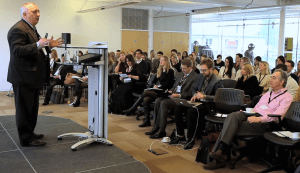 The need for PR professionals to prove the value of their work and provide clients with a quantifiable ROI has never been greater. Recognizing this need, Ketchum London and PRmoment recently hosted a conference on PR Analytics for senior PR and communications professionals. The great line-up of speakers included David Rockland, Partner/CEO, Ketchum Global Research and Ketchum Change and representatives from organizations including McLaren Automotive, Oxfam, AMEC, and Ebay who shared their thoughts and experiences with the 90+ attendees.
The need for PR professionals to prove the value of their work and provide clients with a quantifiable ROI has never been greater. Recognizing this need, Ketchum London and PRmoment recently hosted a conference on PR Analytics for senior PR and communications professionals. The great line-up of speakers included David Rockland, Partner/CEO, Ketchum Global Research and Ketchum Change and representatives from organizations including McLaren Automotive, Oxfam, AMEC, and Ebay who shared their thoughts and experiences with the 90+ attendees.
The long running debate on how the impact of PR can be quantified seems to be drawing to a logical conclusion and defined approaches to measure communications programs have emerged. However, there is still inertia in the PR industry towards analytics and measurement partly because of the belief that creativity cannot be quantified. The speakers argued that this was not true.
Also, as measurement costs 4-7% of the budget, PR practitioners choose rather to invest that money in glamorizing their campaign by hiring a celebrity. But as one speaker pointed out, clients these days have a – “if you can’t measure it, it doesn’t exist” – approach. The advantage of measurement is two-fold. It not only helps PR professionals gauge the impact of their campaign but also helps in refining future programs.
Social and online media have provided a plethora of PR opportunities. However, there is still a lot of confusion over how their ROI can be determined. The speakers demystified social media measurement and suggested some useful techniques. Digital impressions are one of the most relied upon metrics when measuring social media campaigns. But are they as accurate as PR professionals think they are?
One of the speakers argued that the number of impressions was a valid metric only if it could be linked to actions, e.g. – customers buying a product or attending an event they saw online. “It wasn’t about output but outcomes”, he added. Another metric which PR professionals tend to emphasize while evaluating a campaign’s success is website traffic. There is no point for a website to have a high volume of traffic if the users ignored the key messages. Also, one of the speakers noted that the insights from Facebook and Twitter – particularly the emotions showed by users on these platforms – could be used to inform the communications strategy and forecast outcomes.
Some of the measurement techniques that the PR professionals were encouraged to use included “recognizing tonality of coverage on scorecards” and measuring share of voice. The use of Google Analytics was also strongly recommended when measuring online PR. It is an inexpensive technology which lets users evaluate what media channels were delivering outcomes and providing real value. These findings can then be used to develop an optimal marketing mix. One of the speakers suggested the use of a global dashboard in which employees could have informed conversations. This was proving to be an effective way of linking internal communications engagement with ROI.
PR is undoubtedly a great marketing strategy. It helps in building a unique trust and affinity with the audiences, which something that no other discipline can achieve. But times are changing and the marketing landscape is evolving. This session confirmed that if the PR industry wants to solidify its place as a vital part of the integrated marketing solution, it must discard flawed and obsolete metrics and start employing sophisticated measurement tools.


